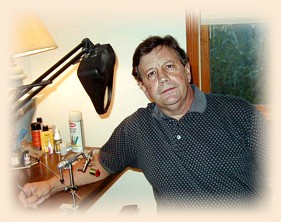This will be the last of the series of flies from the Rangeley Region of Maine. I had
originally intended to extend the series to the featherwing streamers for which the region is best
known, but I find that virtually all of them are already represented here in the archive
of Old Flies. So I will move my focus to the flies of the Adirondacks soon, but a few words about the
streamers of the Rangeley Region are in order first.
By the turn of the century, the wet flies had become more
and more "streamer-like" in the area, that is to say larger,
more like minnow imitations rather than insect facsimiles,
and it was a matter of time before the streamer of today
was developed. Two individuals were more responsible for
this than any others. They were Herbert L. (Herbie) Welch
and Carrie Stevens. Herbie arrived in the area in 1904,
and worked initially as a guide in the region. He invented
his own flies for clients and soon the Black Ghost, Welch
Rarebit (a brilliantly named fly I think), Green Spot, Jane Craig,
and Kennebago came into existence. They featured a feather
wing, angled up at around 45 degrees or so, the wing tied directly
on top of the hook. This design, while quite good, was to be
improved upon dramatically by Carrie Stevens.
Carrie and Wallace Stevens arrived in the region around 1917.
By this time Herbie Welch had a shop, and over time he and
Carrie became friends. Carrie made flies with no vise, had
absolutely no training, and had never even seen anyone tie a
fly. None of these things stopped her, and she would go on to
create one of the greatest American flies, the Gray Ghost. This
fly is still used very effectively today. Carrie went on to sell her
flies throughout the region, and eventually around the world. The
big difference between her flies and the streamers of Herbie Welch
was the attitude of the wings. Hers were assembled as glued sides,
and tied in along the sides of the body, rather than on top of the hook.
There were many other subtle things she did to get her flies to
realistically imitate minnows, and the Gray Ghost is still one of the
best shad imitations one can use. Herbie Welch, when asked to
name the top two flies to use in the region, named Carrie Stevens' Gray
Ghost as number one, and his own Black Ghost as number two, not
insignificant praise from the inventor of the streamer. It has been said
that Herbert Welch invented the streamer, and Carrie Stevens perfected
it, and I think history has born this out.

Now off to Indian Rock! The engraving above, found in Charles
A. J. Farrar's book Through the Wilds,
shows a view from Indian Rock of Camp Kennebago, home of
the Oquossoc Angling Association. The rock itself is located
on the shores of Mooselookmeguntic, at the outlet of Kennebago
River on the south side. This view is looking across
the Kennebago, at the Oquossoc club on the north shore of the
river.
The rock was an old Indian meeting ground, and is still
a hub of activity on Mooselookmeguntic today. The original
managers of the club tried to retain "all the charming
semi-aboriginal character in their camps, grounds, and appointments"
according to Farrar. I got quite a kick out of this sentence in his
description: "There are good accommodations for ladies at Camp
Kennebago during the months of July and August, as at that time there
are very few members of the Association in the camp. " Of course,
they weren't in the camp because July and August were the height of the black
fly season. I'm just speaking for myself here, but none of this would fly with
my wife for two seconds today. But this was a time when women didn't even
have the vote, and were barred from many men's clubs and associations all together.
I'm sure the July and August policy was considered quite enlightened at the time.
My wife would view this differently.
As for the Indian Rock fly, I would suggest attempting to dress
this one only after long experience with married wings. It is simply
a miserable fly to tie. I wasn't completely happy with the version
pictured above, but simply could not put myself through the ordeal
of trying to do another one. One of the hallmarks of a good fly is ease
of dressing, and this fly fails that test completely. But if you like a
challenge, all I can say is, here's the recipe, have at it!
Indian Rock
Tip: Silver tinsel
Tail: Mallard over crimson
Body: Peacock herl
Hackle: Crimson tied palmer
Wing: Gray mallard and crimson
Credits: Camp Life in the Wilderness by
Capt. Charles A. J. Farrar; Through the Wilds by
Capt. Charles A. J. Farrar; Carrie Stevens by Graydon
R. Hilyard; Trout by Ray Bergman; ~ EA
About Eric:
 Eric lives in Delaware, Ohio and fishes for brown trout in
the Mad River, a beautiful spring creek. More of his flies
are on display here:
Traditionalflies.com -- Classic salmon and
trout flies of Europe and the Americas.
Eric lives in Delaware, Ohio and fishes for brown trout in
the Mad River, a beautiful spring creek. More of his flies
are on display here:
Traditionalflies.com -- Classic salmon and
trout flies of Europe and the Americas.
|



 Eric lives in Delaware, Ohio and fishes for brown trout in
the Mad River, a beautiful spring creek. More of his flies
are on display here:
Traditionalflies.com -- Classic salmon and
trout flies of Europe and the Americas.
Eric lives in Delaware, Ohio and fishes for brown trout in
the Mad River, a beautiful spring creek. More of his flies
are on display here:
Traditionalflies.com -- Classic salmon and
trout flies of Europe and the Americas.